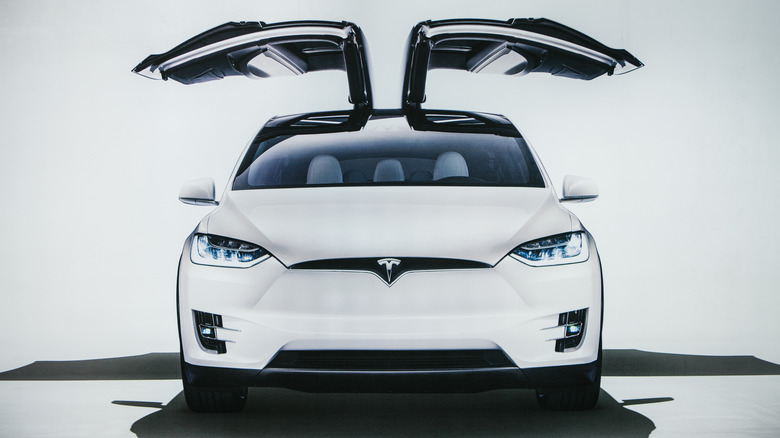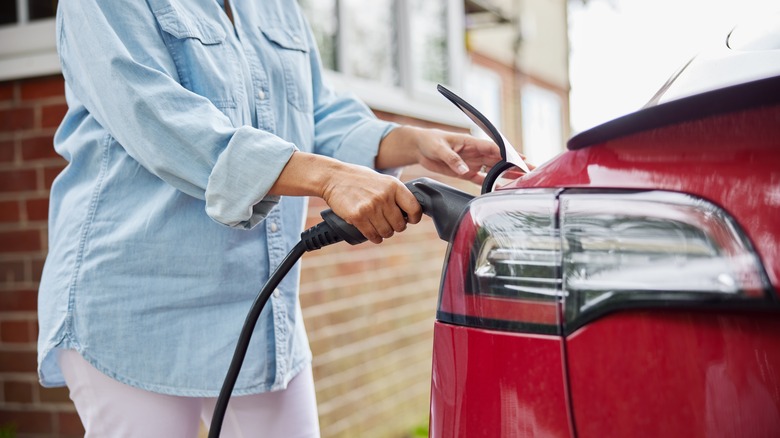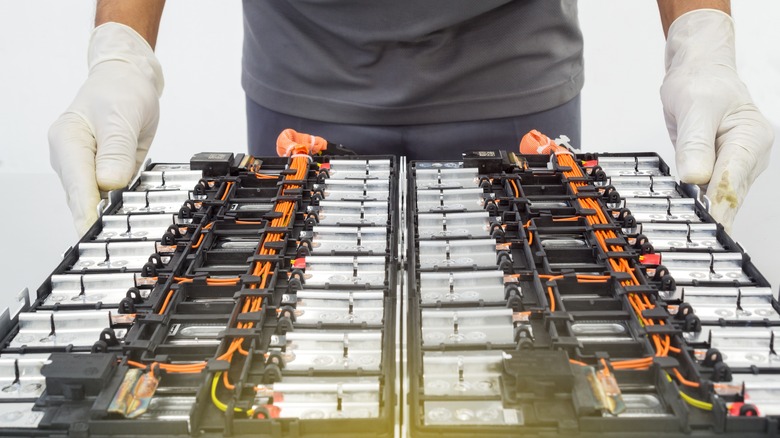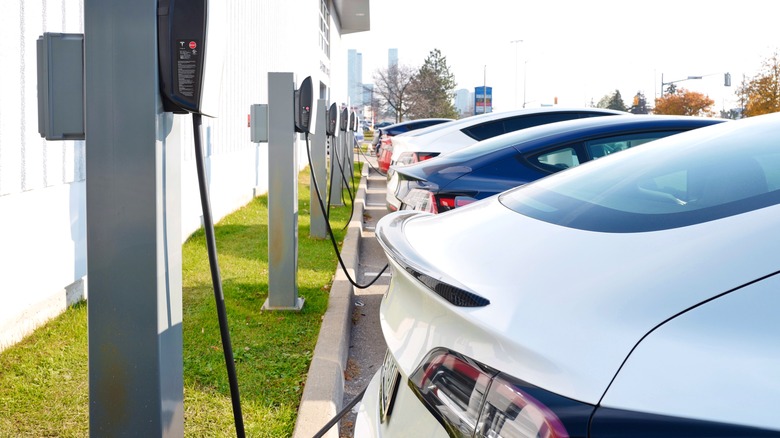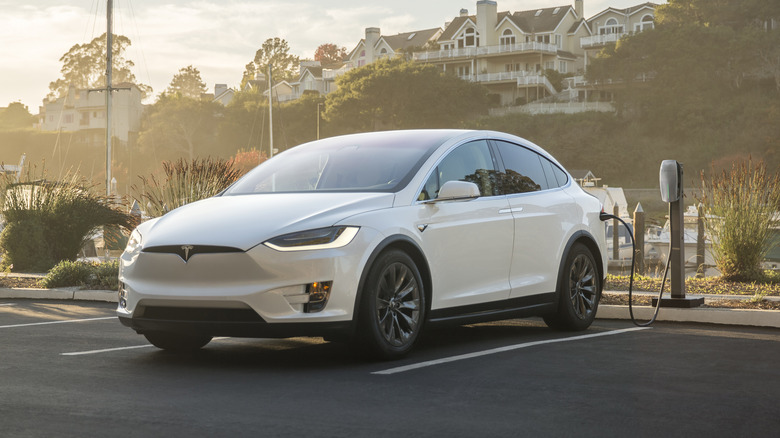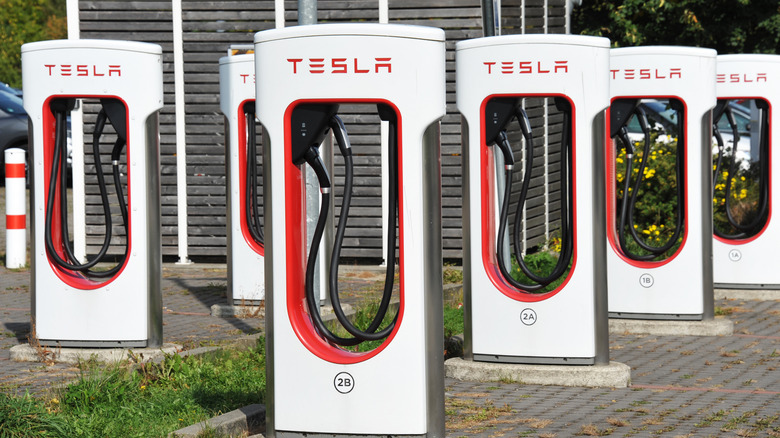How Long Does It Take To Charge A Tesla Model X?
Tesla's Model X is the electric car company's take on the SUV, offering more space for storage and passengers than the Model Y or Model S while still retaining many of the perks you'd expect from a Tesla. It offers fans of mid-sized vehicles a chance to consider going full electric. However, electric cars have their downsides. When a conventional vehicle is out of fuel, you can go to a gas station and refill the tank in less than five minutes. With electric vehicles (EVs) it's a different story.
Issues surrounding recharging are some of the biggest concerns the public has about electric vehicles, and a major barrier to adoption. But are those concerns even justified? In the case of the Model X, they may not be. Under ideal circumstances, the electric SUV can get its range back faster than you might think. While EV technology has come a long way to get us to this point, it may also be getting better in the near future. Here's a look at the factors playing into your Tesla Model X's charging cycle, and what that means for recharging times.
Your charging station matters
Tesla's Supercharging network is widespread, and while it may now be open to other vehicles in many countries, the network's focus is firmly on its core customer base. Surprisingly though, a Supercharger station may not be your best option when it comes to charging your Tesla as quickly as possible. There are currently three kinds of Supercharger stations and three types of EV chargers. The Supercharger stations currently on the market are labeled V1, V2, and V3. V2 chargers aren't the most powerful, but they do make up the bulk of Supercharger stations. As far as regular chargers go, there are currently Level 1, 2, and 3 chargers available — and they will require the use of an adapter if you want to charge your Tesla at one.
Level 1 chargers are the things regular EV owners get with their vehicles. They plug into a 120V outlet in the owner's home and charge the vehicle very slowly. The rate varies but at best you're looking at five miles of range every hour. If you used one of these, instead of getting 200 miles in 15 minutes like Tesla claims you can with a Supercharging station, you'll be looking at close to two days of charging. Level 2 chargers are a lot better, providing up to five times the range per hour of Level 1 chargers. Level 3 chargers are where things get interesting. Level 3 chargers offer 350 kW of DC power, whereas Tesla's Supercharger stations only offer 250 kW. Tesla may tailor its stations to its vehicles via software, so it may get an edge there, but that edge might not be enough. According to a test performed by Inside EVs, a Level 3 charger may charge your Tesla faster than the company's own stations.
Spending too long at the charger is bad for your battery
You may believe a fair way to measure an electric car's charging time is by noting how long it takes to its battery from empty to full. While that seems to make sense, things are actually a little bit more complicated than that.
In electric cars and other objects that use lithium-ion batteries, chargers can get to around 80% capacity quite rapidly. After that, things tend to slow down drastically, and for good reason. It can take just as long to get a lithium-ion battery from 80% to 100% as it took to get it to 80% from flat. This is because fuller batteries are in danger of overheating if fast charging is used, so multiple charging phases are usually built into the batteries to protect them from damage. It's also a bad idea to keep a lithium-ion battery fully charged, ideally battery levels should be kept between 80% and 100%. With electric vehicles especially, fast charging may not kick in unless the battery's charge level is above 20% but below 80%, so keeping your EV's "tank" in this zone means you'll both preserve your battery, and waste less time at the charger.
Electric vehicles don't need to be charged all the way
With electric vehicles especially, it's easy to argue that you really don't need a full charge. While you're also damaging your phone and laptops by keeping the battery full to the brim — replacing the battery in those devices is far cheaper, as is simply replacing the devices themselves. No matter how careful you are, an EV's batteries will probably need replacing at some point. But if you do your best to protect your car's juice box, then you can at least delay an incredibly major expense. Maxing out your battery can also make your car "less energy efficient" according to Tesla CEO Elon Musk. Musk recommends limiting charges to around 90%, so the car's regenerative braking system has a chance to contribute. The system uses the energy that is usually lost when braking to generate a small amount of electricity which is then funneled back into the battery. If the battery is full, it has nowhere to safely send that charge so the system is switched off.
But the main reason you shouldn't fully charge an EV is time. If you decide to charge before your battery level drops below 20%, and fill it back up to around 80%, you'll more than likely be taking advantage of the fastest charging speeds available. Fast charging can be four times quicker than the safer method your battery will use when it's close to empty or at full capacity, you'll technically have to charge it more often, but those charging sessions will be shorter. This method also makes sense on road trips, you can get 200 miles of range in around 15 minutes and use that time to grab a coffee, take a bathroom break, or stretch your legs.
So how long does it take to charge a Tesla Model X?
If you've splashed out on a Tesla, it's recommended you get a 3-phase 32A charger as well. This can get your Model X from 0 to 100% in about 7 hours, which means an overnight at-home charge is very practical. This is the quickest at-home method, with a 3-phase 16A charger adding over three hours to the charge time and a 120v wall plug taking over two days. As far as charging stations go, the 250 kW DC Supercharger station will get you from flat to 80% in just 30 minutes (via EV Box).
But what if you don't care about your battery health and want a full charge every time as quickly as possible? Using your app to remove the 80% limit is probably a bad idea, as you'll still be getting charged fast charging prices for what will essentially be a cheaper charging method, but it can be done. If you do remove the restriction, you'll get the equivalent of Level 2 charging which provides around 14.2 kilowatts of juice per hour. So you could top up that remaining 20% in an hour and a half, giving you a two-hour charge time in total.
Things may get better in the near future
Tesla's chargers are getting a huge upgrade at some point in the future. Existing level three chargers, which vehicles like the Model X can use, have a 350 kW output, which is 100 kilowatts more than Tesla's top-end V3 Superchargers are currently producing. That gap may narrow when a long-awaited software upgrade comes into effect which will boost the V3 Supercharger's output to 300 kW. While this boost may seem minor, it could have a huge impact on vehicle charging times. The exact details of how it may change the Tesla charging game are thin, and not many details have emerged since the upgrade was announced back in the summer of 2021.
The V3 upgrade isn't the only charging boost Tesla has on the horizon. The company has also revealed its plans for a one-megawatt V4 Supercharger. This new charger will be aimed at the company's larger vehicles, namely, the brand-new Tesla Semi and the long-awaited Cybertruck, and no plans have been mooted to expand access to its smaller models. However, as the Model X is the largest standard vehicle — it is likely to be on the list should access to V4 charging expand following its launch.
